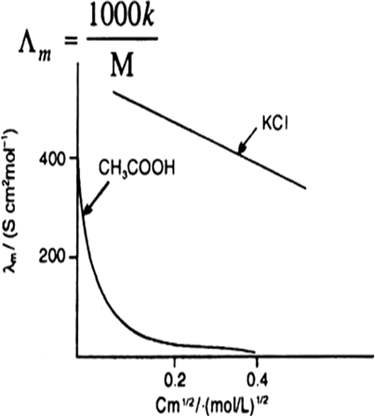Ask questions which are clear, concise and easy to understand.
Ask QuestionPosted by Diksha Singh 1 year, 9 months ago
- 0 answers
Posted by Seema M K 3 years, 10 months ago
- 2 answers
Aseem Mahajan 3 years, 6 months ago
Posted by Roshni Kumari 4 years, 2 months ago
- 0 answers
Posted by Panav Srivastava 4 years, 6 months ago
- 1 answers
Sia ? 4 years, 6 months ago
Solid-state chemistry, also sometimes referred as materials chemistry, is the study of the synthesis, structure, and properties of solid phase materials, particularly, but not necessarily exclusively of, non-molecular solids.
Posted by Kundan Kumar 4 years, 11 months ago
- 1 answers
Posted by Vivek Choudhary 4 years, 11 months ago
- 1 answers
Gaurav Seth 4 years, 11 months ago
Physical properties of Phenols
• Phenols are colourless liquids or crystalline solids but become coloured due to slow oxidation with air.
• Due to the presence of strong intermolecular hydrogen bonding, phenols have a higher boiling point than the corresponding hydrocarbon or aryl halides.

• Due to their ability to form hydrogen bonds with water, phenols are moderately soluble in H2O.
• The phenols are acidic in nature and stronger acids than alcohols. This is due to the fact that the sp2 hybridised carbon of phenol to which −OH is attached, is highly electronegative which causes a decrease in electron density on oxygen. This Increases the polarity of O−H bond and results in an increase in ionisatlon of phenols than that of alcohols.

Moreover, the phenoxide ion so produced is stabilised by the delocalization of charge in phenol.

Note: The presence of electron withdrawing group like NO2 group, increases the acidic strength whereas the electron donating groups like an alkyl group decreases the acidic strength. Therefore, the acidic strength order is

Posted by Md Arif 5 years, 1 month ago
- 1 answers
Yogita Ingle 5 years, 1 month ago
Nitrogen is found in a diatomic form with a triple bond between two atoms. N2 molecules are held together by weak van der Waal's force of attraction which can be easily broken by the collision of the molecules. So, N2 is a gas at room temperature.
Posted by Punam Kumari 5 years, 1 month ago
- 1 answers
Yogita Ingle 5 years, 1 month ago
Rigidity is defined as the property exhibited by the solid to change in its shape.
Posted by Muskan Singh 5 years, 2 months ago
- 1 answers
Posted by Chandgiram Chandgi 5 years, 3 months ago
- 0 answers
Posted by Moksha Maheta 5 years, 3 months ago
- 0 answers
Posted by Komri Bogo 5 years, 5 months ago
- 0 answers
Posted by Kumar Aman 5 years, 6 months ago
- 0 answers
Posted by Kumar Aman 5 years, 6 months ago
- 1 answers
Yogita Ingle 5 years, 6 months ago
Molar mass of NaOH = 40g per mole
no. of moles in 5g of NaOH = 5/40 =0.125
volume of solution=450mL= 0.45 L
molarity of solution=no.of moles of solute/volume of solution
=0.125/0.45
=0.277777777778=0.28(approx.)
Posted by Harsh Raj 5 years, 7 months ago
- 2 answers
Jiban Majumdar 5 years, 5 months ago
Many students get confused about the terms 'Conductance' and 'Conductivity'. The inverse of resistance is called Conductance(C or G) and the inverse of resistivity, ρ(Greek, rho) is called Conductivity(κ) ( or specific conductance), κ = 1/ρ. Thus, conductivity of a solution is the conductance of 1 cm3(or 1 m3) of the solution of the electrolyte. One should use the term 'Molar conductivity' rather than 'Molar conductance'.
Gaurav Seth 5 years, 7 months ago
Conductivity: The reciprocal of resistance of an electrolyte in aqueous solution is known as its conductivity. It is equal to
Molar Conductivity: Molar conductivity of a solution is defined as the conductance of all ions present in one mole of electrolyte in the solution. If M is the molar concentration in mol L–1, then.

Fig: Molar conductivity versus C1/2 for acetic acid (week electrolyte) and potassium chloride (strong electrolyte in aqueous solutions)
The curve shown below gives the change in conductance against square root of concentrations. We observe that for strong electrolytes like KCl, the conductance does not change much with decrease in whereas in the case of weak electrolyte like acetic acid (CH3COOH) it increases much with decrease in
Posted by Bhupendra Yadav 5 years, 7 months ago
- 0 answers
Posted by Pratap Singh 5 years, 8 months ago
- 0 answers
Posted by Amit Das 5 years, 8 months ago
- 1 answers
Md Fardeen 5 years, 5 months ago
Posted by Mahesh Wakchaure 5 years, 9 months ago
- 1 answers
Yogita Ingle 5 years, 9 months ago
Atomic size gradually decreases from left to right across a period of elements. This is because, within a period of elements, all electrons are added to the same shell. However, at the same time, protons are being added to the nucleus, making it more positively charged.
Hence from Ti to Cu as atomic size decreases, the density of the element increases.
Posted by Jasmeen Kaur 5 years, 9 months ago
- 0 answers
Posted by Sajid Alam 5 years, 11 months ago
- 0 answers
Posted by Smdance Videos 5 years, 11 months ago
- 0 answers
Posted by Shashi Sharma 6 years, 3 months ago
- 1 answers
Posted by Lingala Rajasekhar 6 years, 5 months ago
- 0 answers
Posted by Mahesh Patel 6 years, 5 months ago
- 0 answers
Posted by Anshika Chouhan 6 years, 6 months ago
- 1 answers
Amit Sharma 6 years, 2 months ago
Posted by Aadarsh Kumar 6 years, 6 months ago
- 4 answers
Posted by Md Saquib 6 years, 7 months ago
- 0 answers

myCBSEguide
Trusted by 1 Crore+ Students

Test Generator
Create papers online. It's FREE.

CUET Mock Tests
75,000+ questions to practice only on myCBSEguide app
 myCBSEguide
myCBSEguide